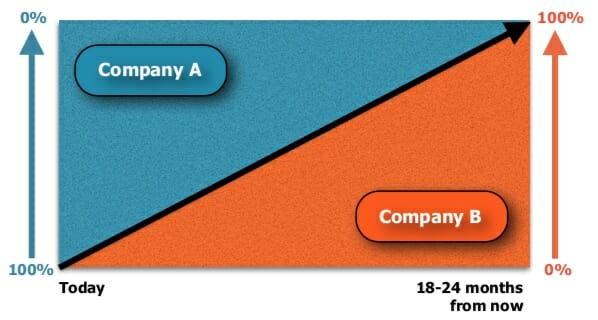April Fools Day was the 10th anniversary of the end of my so-called career in marketing and advertising.
But this isn’t about that.
This is about what I was doing when I was pretending to run the advertising agency — and since.
For a couple decades (possibly longer), I’ve led rooms of bankers, artists, school children, survivors, congregants in a variety of activities that might help when they need to solve a problem or achieve an opportunity.
The Three Top Activities
During the past eight years, after I present to Vistage CEO peer groups around North America, the members call me the next day. They usually say one of three activities really helped. “That changed everything.”
One of the Top Three is Company A / Company B. (The other two are a lesson on active listening and an alternative for anger.)
This is about Company A / Company B.
Where It Started
I never liked telling adults what to do. (I’ll write more about that another day.)
Eventually, the advertising agency needed an adult to tell the rest of us what to do. I hired Mary Spittler (then Mary Kall) as our CEO and Managing Director. Mary agreed to be our boss and we were, immediately, grateful.
One of Mary’s first suggestions was based on an observation. (Her observation was called “Agency A / Agency B,” but I’m going to refer to it as “Company A / Company B,” because it works for more than agencies.)
Mary said:
It seems that we want to be something we aren’t, something that we, perhaps, aren’t yet, something that we are working to become.
Today, we are Company A. As Company A, we are known for our professional staff who offer our clients our set of services, with our methods and pricing. That’s Company A. We produce Company A outcomes.
But we seem to want to be Company B: known for different services, different pricing, serving different clients. This might require different methods and different staff. That’s Company B. We want to produce Company B outcomes.
The problem is: we resist becoming Company B because we can’t stop being Company A. We rely on Company A’s revenues — and, therefore, we rely on Company A’s clients and Company A’s staff (and offerings, methods and pricing).
How do we become Company B? It’s like we need to rebuild the airplane in midflight.
This Is Company A / Company B
Print this document: Company A / Company B. (If this doesn’t print easily, and you are reading this in an email, visit artie.co for the original link.)
(This is excerpted from a larger creativity tool, available here.)
How To Prepare It
Invite your team to complete the Company A section. They can use or ignore the line-by-line prompts (products, services, people, etc.). The words can be technical or colorful. Whatever comes to mind that describes “how we do business today.”
Your team knows Company A. They work there right now.
Company B is harder to describe. Perhaps you might invite your team to describe “where we are going” and “what we want to become.” Whether they help, or you do it alone, the eventual job of defining Company B falls to the leader. That’s the leader’s job: articulating what we plan to be.
Note: part of the description of Company A will be repeated in the description of Company B. Usually, there are aspects of Company A that we do not want to lose.
Once these two sections are completed, you are holding a one-page change management plan.
How To Apply It
Once Company A and Company B are defined, we live them. Here’s how:
- Everyone in the company (from the receptionist to the CEO) has the right — even the obligation — to ask others, “Is what you are doing Company A or Company B?” “Is that a Company A pen or a Company B pen you are buying?” “Are you hiring this person for Company A or Company B?” (If we are recruiting for Company A, we tell applicants, “This work is temporary. Company A is hiring and we are transitioning toward Company B. Perhaps we can develop and eventually reallocate the person we hire to Company B.”)
- There is no blame or shame for working for Company A or Company B. This is not a game of gotcha. It’s simply a way of knowing — and reminding ourselves — that we are operating two companies, A and B, at the same time. And that it is important to know which company we are serving at any one moment.
What Happens Next?
- Early on, someone does something so strange that others ask, “What are you doing?” The answer: “Company B. Is it too soon? Did I misunderstand what Company B does?”
- Later, someone does something so strangely old-fashioned that others ask, “What are you doing?” The answer: “Company A. I’m still working on Company A. Did we shut that down?”
The Graphic Is Not Quite Right
 There are at least three problems with the graphic image:
There are at least three problems with the graphic image:
- It looks like all of Company A is erased. Usually, we retain many aspects of Company A.
- The timeframe might not be right for you. If you are a technology company, you might move from Company A to Company B in months, if not weeks. If you are a municipality, you might evolve in years, if not decades.
- To be sure, there was a company before Company A. And Company C might emerge before we are fully Company B.
An Odd Twist
There’s another use for Company A / Company B. I’ve added that — and a couple odd implementations — here: https://artieisaac.com/blog/2018/04/company-a-company-b-part-2/.
Please share this post and my tools freely. No permission needed.
Invite friends to subscribe to Net Cotton Content at artieisaac.com/subscribe.
Thank you!
